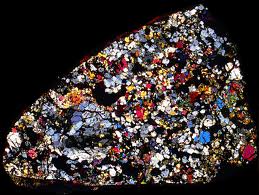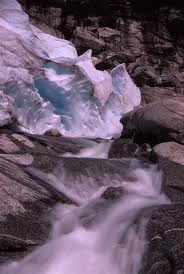

Building Blocks of Life Created in “Impossible” Place
NASA-funded scientists have discovered amino acids, a fundamental building block of life, in a meteorite where none were expected.
“This meteorite formed when two asteroids collided,” said Dr. Daniel Glavin of NASA’s Goddard Space Flight Center, Greenbelt, Md. “The shock of the collision heated it to more than 2,000 degrees Fahrenheit, hot enough that all complex organic molecules like amino acids should have been destroyed, but we found them anyway.” Glavin is lead author of a paper on this discovery that appeared December 15 in Meteoritics and Planetary Science. “Finding them in this type of meteorite suggests that there is more than one way to make amino acids in space, which increases the chance for finding life elsewhere in the Universe.”
Amino acids are used to make proteins, the workhorse molecules of life, used in everything from structures like hair to enzymes, the catalysts that speed up or regulate chemical reactions. Just as the 26 letters of the alphabet are arranged in limitless combinations to make words, life uses 20 different amino acids in a huge variety of arrangements to build millions of different proteins.
The meteorite is a remnant of asteroid 2008 TC3, estimated to have measured just six to fifteen feet across—the first asteroid ever detected in space prior to impacting Earth. After it broke up on entering Earth’s atmosphere, remnants of the asteroid—now in the form of meteorites—landed in the Nubian Desert of northern Sudan on October 7, 2008. A meteorite sample was found to contain 19 different amino acids, in amounts ranging from 0.5 to 149 parts per billion.
The team had to be sure that the amino acids in the meteorite didn’t come from contamination by life on Earth, and they were able to do so because of the way amino acids are made. Amino acid molecules can be built in two ways that are mirror images of each other, like your hands. Life on Earth uses left-handed amino acids, and they are never mixed with right-handed ones—but the amino acids found in the meteorite had equal amounts of the left and right-handed varieties.
The sample contained various minerals that only form under high temperatures, indicating it was forged in a violent collision. The team thinks it’s unlikely that amino acids carried by the original asteroids could have survived such temperatures—more than 2,000 degrees Fahrenheit. Instead, they believe there could be an alternate method for making amino acids in space. “Previously, we thought the simplest way to make amino acids in an asteroid was at cooler temperatures in the presence of liquid water. This meteorite suggests there’s another way involving reactions in gases as a very hot asteroid cools down,” said Glavin.
*******
FOR WATCHERS OF THE SKY, THESE ARE EXCITING DAYS. The recent discoveries pointing toward the likelihood of life beyond the Earth encourage this writer to wonder: Could there indeed be a tendency, or principle, in the Universe that generates and sustains life everywhere? To me, It’s a good thought for the holidays, and somehow I am reminded of an “astro-poem” I wrote, while living in Manhattan Beach, in the far-off December of 1964:
A STAR BEYOND
When dry winds from the east blow down on us
And beat our ocean’s breath back out to sea,
We know December’s here: a sharp-edged month
Of golden afternoon and sudden dusk.
This beach at evening wears a desert face—
Deserted and forgotten by the crowd
Whose distant rush goes silent at the boom
And hush of water, working in the gloom.
We love these desert winds that shape our sky
Into a polished lens for seeing through,
And at some midnight hour bring into view
A star beyond the stars we thought we knew.
Happy holidays, and keep looking up!
You can contact Bob Eklund at [email protected], or visit his website at www.bobeklund.com.
Poem is from the book, First Star I See Tonight, by Robert L. Eklund (www.firststarbook.com). Copyright 2007, Robert L. Eklund.





Be the first to comment